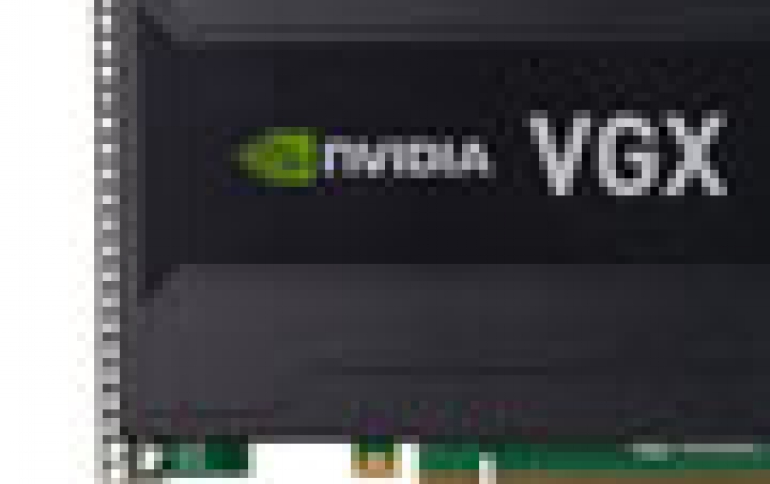
NVIDIA Brings Kepler Graphics To Virtual Workstations
Nvidia on Wednesday relased the NVIDIA VGX K2 GPU, the company's latest VGX board designed for servers delivering virtual desktop applications.
Built on the NVIDIA Kepler architecture, VGX K2 adds workstation capabilities to the NVIDIA VGX platform, which was announced by Nvidia earlier this year.
 The NVIDIA VGX platform utilizes the GPU to allow enterprises to deliver virtualized workstation performance and capabilities -- including rich multimedia and 3D graphics -- to users on smartphones, tablets or PCs. Its VGX K2 board, which includes two workstation-class GPUs, enables enterprises to increase user density without sacrificing performance or application compatibility.
The NVIDIA VGX platform utilizes the GPU to allow enterprises to deliver virtualized workstation performance and capabilities -- including rich multimedia and 3D graphics -- to users on smartphones, tablets or PCs. Its VGX K2 board, which includes two workstation-class GPUs, enables enterprises to increase user density without sacrificing performance or application compatibility.
The NVIDIA VGX K2 includes 4 GB of graphics memory per GPU, promises to minimize the lag traditionally associated with virtual desktop computing and also takes advantage of SMX streaming multiprocessorto provide top performance per watt.
The new card has two GPUs with 1536 cores and 4GB of GDDR5 RAM each, and has a TDP of 225W. NVIDIA's hypervisor supports a "pass-through mode" that can give full control of one of the GPUs to one virtual machine at a time. This means that two users can actually use the VGX K2 in this way at once, but they will be delivered the same capabilities and power that they would have if they were sitting in front of an actual workstation.
Will Wade, director of VGX product line at Nvidia, said that Nvidia's partnership with Citrix gives it an avenue to plug into enterprise certified applications easily. The VGX board, which will work with Citrix HDX 3D Pro, XenDesktop 5.6 FP1 and XenServer 6, is designed for virtual workstations, said Wade.
When used with Citrix compatible virtualization software, users have access to Direct3D, OpenGL, OpenCL, CUDA, and any other feature you'd normally have on a full-fledged desktop.
NVIDIA says that the VGX K2 will eventually support pass-through mode features for multiple users per GPU.
The NVIDIA VGX K2 platform for virtual workstations is expected to be available from server OEMs starting in early 2013.
 The NVIDIA VGX platform utilizes the GPU to allow enterprises to deliver virtualized workstation performance and capabilities -- including rich multimedia and 3D graphics -- to users on smartphones, tablets or PCs. Its VGX K2 board, which includes two workstation-class GPUs, enables enterprises to increase user density without sacrificing performance or application compatibility.
The NVIDIA VGX platform utilizes the GPU to allow enterprises to deliver virtualized workstation performance and capabilities -- including rich multimedia and 3D graphics -- to users on smartphones, tablets or PCs. Its VGX K2 board, which includes two workstation-class GPUs, enables enterprises to increase user density without sacrificing performance or application compatibility.
The NVIDIA VGX K2 includes 4 GB of graphics memory per GPU, promises to minimize the lag traditionally associated with virtual desktop computing and also takes advantage of SMX streaming multiprocessorto provide top performance per watt.
The new card has two GPUs with 1536 cores and 4GB of GDDR5 RAM each, and has a TDP of 225W. NVIDIA's hypervisor supports a "pass-through mode" that can give full control of one of the GPUs to one virtual machine at a time. This means that two users can actually use the VGX K2 in this way at once, but they will be delivered the same capabilities and power that they would have if they were sitting in front of an actual workstation.
Will Wade, director of VGX product line at Nvidia, said that Nvidia's partnership with Citrix gives it an avenue to plug into enterprise certified applications easily. The VGX board, which will work with Citrix HDX 3D Pro, XenDesktop 5.6 FP1 and XenServer 6, is designed for virtual workstations, said Wade.
When used with Citrix compatible virtualization software, users have access to Direct3D, OpenGL, OpenCL, CUDA, and any other feature you'd normally have on a full-fledged desktop.
NVIDIA says that the VGX K2 will eventually support pass-through mode features for multiple users per GPU.
The NVIDIA VGX K2 platform for virtual workstations is expected to be available from server OEMs starting in early 2013.
VGX K1 |
VGX K2 (new) |
|
| Number of GPUs | 4 x entry Kepler GPUs | 2 x high-end Kepler GPUs |
| Total NVIDIA CUDA cores | 768 | 3072 |
| Total memory size | 16 GB DDR3 | 8 GB GDDR5 |
| Max power | 130 W | 225 W |
| Board length | 10.5” | 10.5” |
| Board height | 4.4” | 4.4” |
| Board width | Dual slot | Dual slot |
| Display IO | None | None |
| Aux power | 6-pin connector | 8-pin connector |
| PCIe | x16 | x16 |
| PCIe generation | Gen3 (Gen2 compatible) | Gen3 (Gen2 compatible) |
| Cooling solution | Passive | Passive |





















